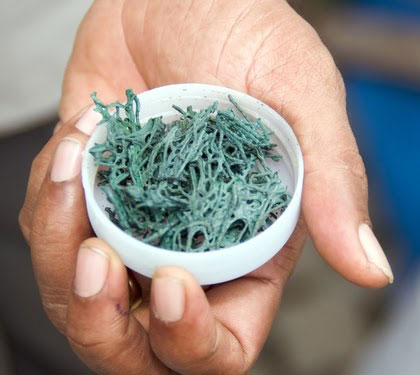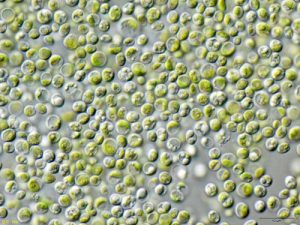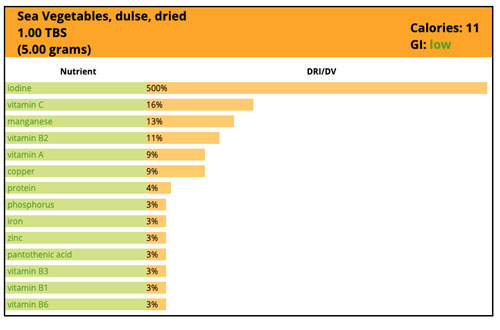I often get questions about sea vegetables. Specifically, those who are curious about controlling their iodine intake but don’t want to miss out on the many nutrients they provide. So, let’s break down the ones you might want to consider, avoid, and what you need to know!
Sea Vegetables: Defined
For starters, today’s discussion will be surrounding plants that, for culinary purposes, are grown in the ocean.
Historically, these have been used as food for quite some time, mostly by cultures who were surrounded by the ocean (and had a strong seafaring culture, in general

This is especially true for the Japanese, the Irish, the Celts, and countries such as these that had a healthy supply of sea vegetables in their diets. Not uncommon at all!
In fact, sea vegetables are one of the best sources of what we know as “umami” flavor (Read More: The Full Story Behind Umami).
Sea Vegetables: Algae
A subset of sea vegetables includes what we know as algae, which includes:
- Spirulina
- Chlorella
Lately, I have been seeing a bit more mixed data about the benefits of spirulina. This includes possibly having effects as a neurotoxin on the body.

If you break it down and look at the organism itself, you will find a lot of studies about how it often has grown in ponds and made cows sick. That’s the bulk of the research right there.
There are now some studies saying the same for humans, too. That’s why I would approach this food with caution and overall wouldn’t consider it as good for your system.
Chlorella
Chlorella is algae, and it is certainly more of a reasonable food option. It may even have some detoxification properties that could be beneficial to the body.
In terms of algae as a subset of sea vegetables, the chlorella does contain iodine. This is something we definitely want to be mindful of going forward.
It is not bad for us, but we do want to consider reasonable amounts so as not to disrupt the function of our thyroid.
Key Insight: In fact, you can do fine with chlorella up to 3,000 milligrams per day. This is the same as about 3 grams per day.
I am confident in this after breaking down a significant amount of assays, regarding chlorella, which shows a consistent amount of iodine every time.
That’s because a lot of the things that contain iodine often have pretty erratic amounts. Chlorella, though, is consistent in its amounts almost every time.
The Different Types of Sea Vegetables
After breaking down algae, let’s think about some of the different types of sea vegetables that may (or may not) be familiar with:
- Kelp
- Hijiki
- Wakame
- Arame
- Dulse
- Nori
The main thing that most of these contribute to the diet is iodine. In fact, the chart below showcases how much you can expect from each of the most common sea vegetables:
| Type of Sea Vegetable | Mcg of iodine per 1 ounce serving | %RDI |
| Laminaria, fingered tangle, harvested from Iceland, granules | 244950 | 163300.00% |
| Laminaria, fingered tangle, harvested from Maine, whole grain | 89520 | 59680.00% |
| Laminaria, mitsuishi-kombu (L. Agustata), harvested from Japan, powdered | 70590 | 47060.00% |
| Ecklonia maxima, paddle weed, harvested from Namibia, whole grain | 63690 | 42460.00% |
| Laminaria, fingered tangle (L. Digitata), harvested from Maine, whole | 59910 | 39940.00% |
| Laminaria, oarweed, harvested from Maine, whole grain | 55860 | 37240.00% |
| Laminaria, kelp, harvested from British columbia canada, whole grain | 45390 | 30260.00% |
| Laminaria, wild kelp, harvested from Amine, capsule | 40680 | 27120.00% |
| Laminaria, kombu, harvested from Washington, whole grain | 40500 | 27000.00% |
| Laminaria, kelp, harvested from british columbia canada, capsule | 37770 | 25180.00% |
| Postelsia palmaeformis, sea palm. Harvested from California, whole grain | 26130 | 17420.00% |
| Laminaria, L. longicruis, harvested from Maine, whole grain | 22380 | 14920.00% |
| Ascophyllum nodosum, knotted wrack, harvested from main, whole grain | 19380 | 12920.00% |
| Hizikia fusiforme, Hijiki, harvested from Japan, whole grain | 18870 | 12580.00% |
| Laminaria, kelp,harvested from Japan, whole grain | 18870 | 12580.00% |
| Laminaria, oarweed, harvested from Japan, whole grain | 18870 | 12580.00% |
| Eisenia bicyclis,arame,harvested from Japan, whole grain | 17580 | 11720.00% |
| Alaria esculenta, wakame, harvest from maine, whole grain | 12930 | 8620.00% |
| Fucus vesiculosus, bladderwrack, harvested from maine, whole grain | 8280 | 5520.00% |
| Undaria pinnatifida, wakame, harvested from New Zealand, whole grain | 3450 | 2300.00% |
| Alaria esculenta, wakame, harvest from maine, whole grain | 3300 | 2200.00% |
| Palmaria palmata, dulse, harvested from Maine, whole grain | 2160 | 1440.00% |
| Undaria pinnatifida, mekabu, harvested from Tasmania, powder | 1590 | 1060.00% |
| Undaria pinnatifida, wakame, harvested from Japan, whole grain | 1260 | 840.00% |
| Undaria pinnatifida, wakame, harvested from Tasmania, whole grain | 1230 | 820.00% |
| Undaria pinnatifida, wakame, harvested from Tasmania, powder | 960 | 640.00% |
| Sargassum, horsetail tangle, harvested from Washington, whole grain | 900 | 600.00% |
| Undaria pinnatifida, mekabu (undaria spore), harvested from Tasmania, tablets | 660 | 440.00% |
| Porphyra tenera, nori, purple laver, harvested from Japan, sheet | 480 | 320.00% |
In most cases, we discuss “serving size” as being roughly 1 ounce. So, whenever you see information about how much nutrition a food gives you, you have to think about in terms of nutrients per practical serving size.
Serving Sizes: Sea Vegetables
Some serving sizes of sea vegetables talk about a gram of them (or even a tenth of a gram). The fact is that these just are not realistic, they are far below what is typical of serving sizes for your average person.
Key Insight: When it comes to serving sizes, we’re typically talking about an ounce or a couple of ounces.
For an ounce intake, the chart above illustrates quite clearly how the micrograms of iodine per serving correlate with recommended daily intakes. This isn’t even getting into whether this is the recommendation for everyone.
What Are We Missing Out On?
So, if we aren’t enjoying a lot of these foods, what’s missing from our diet? Basically, what is the opportunity lost from cutting these out of our diets?
Let’s take a look at the nutrient breakdown for dulse to illustrate my point:

This is about a one-tablespoon serving of what we might find in dulse. If you look at everything besides iodine, it does have about a tenth of one’s daily need for a few nutrients. This includes:
- Vitamin C
- Manganese
- Vitamin A
- Copper
These are not hard nutrients to find in an overall healthy diet. If you have some plant foods of any kind, or animal foods and even nuts and seeds, you can get those nutrients pretty readily.
The toughest ones to find, which you can find in dulse, are likely iron and zinc. While sea vegetables contain it, they are not rich sources of it. If those are nutrients that you are low in, it won’t move the needle much.
Key Insight: You would have to consume 33 ounces, per day, of sea vegetables to get a reasonable serving of zinc or iron. That would be ridiculous!
Sea Vegetables as Food Additives

The other common thought here is how often sea vegetables are used as food additives. Here’s where you’ll see them:
- Carrageenan
- Alginates
- Agar-agar
Any of these are commonly added to processed foods for texturizing purposes. In doing so, that often ends up giving these foods really high amounts of iodine.
Key Insight: The biggest issue that I have found, specifically with carrageenan, is the high, unstable amount of iodine provided in them.
You can find it in processed foods including:
- Ice cream
- Lunch meats
- Almond milk
- Baby formula
- Whipped cream
- Chocolate products
- Syrups
- Creamer
- Many others
Because of the presence of carrageenan, these foods can have really drastic amounts of iodine in them. This is definitely a huge issue and something you should know about.
Radiation and Sea Vegetables?
I have read some stories about sea vegetables and their radiation content. Honestly, I do not find that a compelling argument one way or the other.
There is a limited amount of data suggesting it, and it’s not consistent enough to build a reliable argument around the topic.
Sea Vegetables: What To Know
The main thing you need to take away from our discussion today is that sea vegetables just have so much iodine in them.
And, while they do have other nutrients, these are nutrients that you can easily access from a variety of other foods in a balanced diet. They are not hard to find.
Here are some action steps that you can consider:
- Don’t consider sea vegetables as a mandatory part of your diet
- Avoid sea vegetables if you have any thyroid concerns
- Chlorella can be optional as it may have health benefits of note
- You may consider rice bran fiber and spinach for similar benefits
Bottom Line: Overall, it is best to minimize our consumption of sea vegetables. This is especially true for those we can find as texturizing elements in processed foods.
Take The Next Step Today
Now that you know a bit more about sea vegetables and your thyroid, how about taking the Thyroid Quiz? You can find it right here (Click Here: Take The Thyroid Quiz Today), and it can help unlock action steps to realize the full potential of your health.

1. Schedule a Thyroid Second Opinion with me, Dr. C, Click Here for Details
2. Download and use my Favorite Recipes Cookbook Here
3. Check out my podcast Medical Myths, Legends, and Fairytales Here
Dr. Alan Glen Christianson (Dr. C) is a Naturopathic Endocrinologist and the author of The NY Times bestselling Adrenal Reset Diet, The Metabolism Reset Diet and The Thyroid Reset Diet.
Dr. C’s gift for figuring out what really works has helped hundreds of thousands of people reverse thyroid disease, lose weight, diabetes, and regain energy. Learn more about the surprising story that started his quest.


